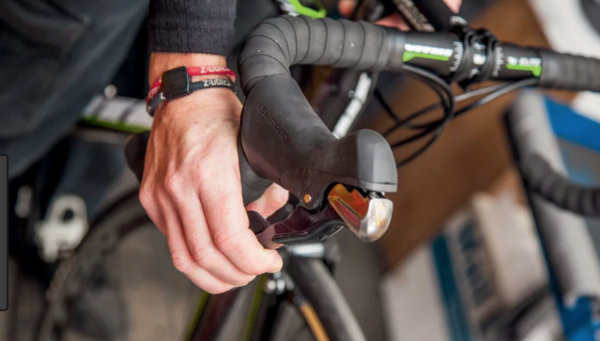You may have noticed a clunking noise in your front end. You might feel a bit of play in your steering. You might notice more vibration than you think is normal. All of these symptoms are typical of loose bike headsets. Bike steering adjustments are routine, and nothing you can’t handle yourself.

Bike Steering
Bike steering is made possible by your headset. The headset is a rotating joint at the bottom of the stem. It allows the steering column (tube) and front wheel to rotate and turn. The headset is your focus for bike steering issues. All you need to fix it is your multi-tool, or alternatively a 4-mm, 5-mm or 6-mm hex wrench, depending on model of bike. Tightening your headset is one of the most basic of all bike maintenance procedures.
Quick Test For a Loose Headset
If you’re not sure about bike steering or your headset, a quick test will help you decide if it needs attention, here’s how to do it: Apply pressure to your front brake by squeezing the lever. Place your other hand on the front of the stem, just above the fork. Rock the bike forward and back. If you feel a slight knocking your headset is loose. If you look close, you may even be able to see a slight separation (very slight) between the steering tube and the bushing when you rock the bike. A loose headset may also produce a more dramatic clunking sound when you bounce the front tire, or if you hit a bump when riding. That sharp clunk when you pass over railroad tracks is a perfect example.
Step One: Loosen the Pinch Bolts
Your bike should have two pinch bolts (some people call them stem clamp bolts) located on the vertical part of the stem facing the seat. The bolts are horizontal and perpendicular to the top tube, and a critical part of bike steering. Note that one bolt typically enters the stem from the left, and the other from the right. Loosen them just enough so that the stem goes slack, or that you can move the handlebars without turning the wheel. Start with the 5-mm hex wrench, if it doesn’t fit, use the 4-mm or the 6-mm.
Step Two: Tighten the Headset
Tighten the large, vertical bolt (aka pre-load bolt) on the top cap of the stem using the 5 or 6-mm hex wrench. This is important: tighten it only enough to take the play out of the headset. The tightening motion squeezes the parts together (bearing tension) inside the headset, if you get them too tight, your bike steering will be stiff, and it will wear out the headset. In most cases, you won’t need to tighten the bolt more than about 1/4-to-1/2-turn. If you think you’ve over-tightened it, back it off a 1/4-turn.
Step Three: Test It
Grasp the front brake, and rock the bike forward and back. If you hear a clunking it’s not tight enough. If you’re not sure, do the test with your hand on the front of the stem. When you’re satisfied, go to Step four.
Step Four: Align The Handlebars
Your bike steering is still loose at this point. Stand over the bike and do a visual straightening of the handlebars. One way is to center the drop-outs (the ends of the axle on the front tire) with the center of the stem. Or you can just use the tire. This can be tricky, but easy to adjust later if you’ve tweaked it the wrong way. When you’re satisfied that the handlebars are straight, tighten the pinch bolts. These bolts need to be tight, they’re the only thing securing your stem to the steering tube.
Torque and Carbon
Something should be said about over-tightening bolts on bikes, especially carbon-fiber bikes. Even a slight miscalculation in torque can be a very expensive mistake on a carbon fiber frame. That sickening crunch can literally cost you thousands. Here’s how to avoid it: Invest in a bicycle specific torque wrench. A majority of carbon fiber bikes require a setting of 5nM. (newton meters) Using the torque wrench won’t allow you to ruin your carbon fiber frame, because you’ve set it according to manufacture’s instructions. (Don’t use the torque wrench to tighten the top cap bolt on your headset though, that’s a feel thing — unless specified to do so by your bike’s manufacterer).
Check With A Mechanic
If you’re not sure about any of your bolts torque requirements, or how your bike steering mechanism (headset), works, check with your bike’s manufacturer or local mechanic. For extra help, check out the video below!